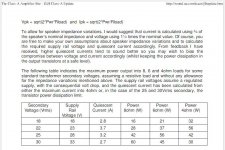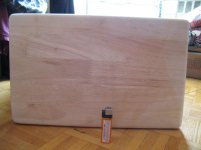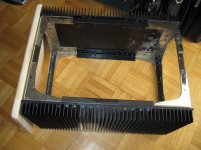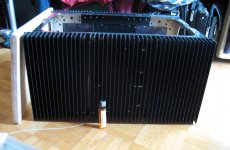Hello Nico/gabor,
Help needed. I plan get a somewhat universal transformer for this and any other future class A amp. What would be a suitable (somewhat luxurious, so that its truly universal trafo) transformer VA for 15VAC, 18 VAC, 20 VAC and 22VAC secondaries for this amp.? all secondaries on the same trafo, so that I can use whichever one that suits that particular class A amp I build.
I am not looking at calculations for minimum VA requirements, but something having 1.5x to 2x the minimum required that will take care of most class A amps requiring these AC secondaries.
I was going to get a 1000VA one , but in these difficult times, its slightly going out of my budget.
Help needed. I plan get a somewhat universal transformer for this and any other future class A amp. What would be a suitable (somewhat luxurious, so that its truly universal trafo) transformer VA for 15VAC, 18 VAC, 20 VAC and 22VAC secondaries for this amp.? all secondaries on the same trafo, so that I can use whichever one that suits that particular class A amp I build.
I am not looking at calculations for minimum VA requirements, but something having 1.5x to 2x the minimum required that will take care of most class A amps requiring these AC secondaries.
I was going to get a 1000VA one , but in these difficult times, its slightly going out of my budget.
Hello Nico/gabor,
Help needed. I plan get a somewhat universal transformer for this and any other future class A amp. What would be a suitable (somewhat luxurious, so that its truly universal trafo) transformer VA for 15VAC, 18 VAC, 20 VAC and 22VAC secondaries for this amp.? all secondaries on the same trafo, so that I can use whichever one that suits that particular class A amp I build.
I am not looking at calculations for minimum VA requirements, but something having 1.5x to 2x the minimum required that will take care of most class A amps requiring these AC secondaries.
I was going to get a 1000VA one , but in these difficult times, its slightly going out of my budget.
Hello prasi
Here is the designer calculation .
Originally he built it as 2 mono blocks, so I am not sure he made the calculation based on that!
Please read it, I hope someone else who already built the amp will share his experience.
For example some people for the 20W Hiraga Class A use a 2X18V 300VA transformer I used for mine 500VA. I do like to oversize the PS start from the transformer. For Pass Aleph30 some used 400VA I used 625VA and the transformer was warm after a few hours usage.
To under size the PS or the transformer one of the worst think we can do at Class A operation. The other hand if we need a 500VA but we use 1KVA it is a waste of money, ad extra weight and need extra room inside the amp enclosure.
Attachments
just got these monsters, 300mmx200mmx83 mm serrated fins.
That's from Pune , right ? Forgot the suppliers name.
That's from Pune , right ? Forgot the suppliers name.
Yes. Just Google akash heatsinks pune
A classA amplifier uses a transformer rated somewhere from 6times to 10times the maximum ClassA output power.
If you have a 50W+50W stereo ClassA amplifier, then you need at least 600VA and could work economically with up 1000VA. Any more than that is wasting resources.
If you have a 50W+50W stereo ClassA amplifier, then you need at least 600VA and could work economically with up 1000VA. Any more than that is wasting resources.
If you buy a big toroid then it will have a big hole in the middle that can accommodate a lot of extra turns.
Buy a 1000VA 16Vac dual secondary.
It will have low regulation and a low Turns per volt.
Add on a bifillar winding that gives 2VAc.
Then add on another bifllar winding for 2Vac and finally a third 2Vac bifillar winding.
You now have the option for 16, 18, 20 & 22Vac dual secondaries.
2Vac could be as few as 4, or 5Turns But you would need thick wire (3.6mm diam). Might be easier to use thinner wire for a paralleled secondary (double 2.5mm diam).
Buy a 1000VA 16Vac dual secondary.
It will have low regulation and a low Turns per volt.
Add on a bifillar winding that gives 2VAc.
Then add on another bifllar winding for 2Vac and finally a third 2Vac bifillar winding.
You now have the option for 16, 18, 20 & 22Vac dual secondaries.
2Vac could be as few as 4, or 5Turns But you would need thick wire (3.6mm diam). Might be easier to use thinner wire for a paralleled secondary (double 2.5mm diam).
Last edited:
Hi
I would not go as low as 2x16V, would start at 2x18V and up, You got those nice pieces of heatsinks those can handle 18V and up especially if you do not use regulators. High power regulators create a lot of heat also.
When you ad some wires to your transformer make sure that does not crate any mechanical noises.
Originally the designer uses 2v18V 300VA per mono block. He uses regulated PS so he get 18VDC.
About the amplifier I didn't have any progress, Last week my lower back pinched (not the first time) the nerve so everything is on hold. I spent the whole week on pain killers and most time at the bed. Monday will see my family doctor, I hope she will send me to a specialist.
I would not go as low as 2x16V, would start at 2x18V and up, You got those nice pieces of heatsinks those can handle 18V and up especially if you do not use regulators. High power regulators create a lot of heat also.
When you ad some wires to your transformer make sure that does not crate any mechanical noises.
Originally the designer uses 2v18V 300VA per mono block. He uses regulated PS so he get 18VDC.
About the amplifier I didn't have any progress, Last week my lower back pinched (not the first time) the nerve so everything is on hold. I spent the whole week on pain killers and most time at the bed. Monday will see my family doctor, I hope she will send me to a specialist.
i recently plugged one off my jlh 69 to a mbl6010 clone and i realy surprised by the result.
more open,very expressive,more clean in bass and mid,more fluide in high,
for the price,this preamp kit is realy good with good alimentation and ad797 guenuine op amp.
i played with micromega "bijou" ,philips cd 471 tweaked and mission pcm 7000
restaured with the same good result
more open,very expressive,more clean in bass and mid,more fluide in high,
for the price,this preamp kit is realy good with good alimentation and ad797 guenuine op amp.
i played with micromega "bijou" ,philips cd 471 tweaked and mission pcm 7000
restaured with the same good result
Compared to what? Can you provide a link to the kit?more open,very expressive,more clean in bass and mid,more fluide in high,
for the price,this preamp kit is realy good with good alimentation and ad797 guenuine op amp.
with nakamichi preamp ,nad preamp,dumortier preamp,hitachi hca 8500mk2 preamp,fiio e10k direct line preamp.Compared to what? Can you provide a link to the kit?
look "mbl6010c and D" on aliexpress.
this one with ad797.
Buy Products Online from China Wholesalers at Aliexpress.com
Thanks, this one? Aliexpress.com : Acquista HIFI Preamplificatore Stereo Adottare AD797 High end Personalizzato MBL6010 D Black Gold Edition Top a livello di sistema Audio Preamplificatore da Fornitori hifi preamplifier affidabili su HIFI diy spare parts center (I couldn't access the link without registering)
Do you need a preamp with your source, have you tried without?
Do you need a preamp with your source, have you tried without?
Hello Gabor,
any update on your build?
regards
Prasi
I have to start to etch the PC boards and go on with these project. Same time I etch PC boards for a dozen other amplifiers. I need to rebuild the amplifier case I used US standard screws and they loosen up (my heat sinks are heavy) if I tide the screws harder it damage the taping. I purchased from China M6 tap true Ebay to re tap the heatsink and waited 2 mounts to receive it.
Meanwhile I put together another amplifier case but to big to use for these (would be waste) project, I think that can handle 50-60W Class A PP amplifier like the KSA 50.
Now no more excuse I have to start to put these amp together.
Greetings gabor
Attachments
Member
Joined 2009
Paid Member
I have to start to etch the PC boards and go on with these project...
Hi Gabor,
One thing you could consider is adding a rail filter on your pcb layout - you don't have to populate it. In my version of the amplifier I incorporated a simple rail filter and there is no hum at all. In simulation it was very effective too
TGM9 - my version of the JLH '69 Class A amplifier
see post: 16
I have to start to etch the PC boards and go on with these project. Same time I etch PC boards for a dozen other amplifiers. I need to rebuild the amplifier case I used US standard screws and they loosen up (my heat sinks are heavy) if I tide the screws harder it damage the taping. I purchased from China M6 tap true Ebay to re tap the heatsink and waited 2 mounts to receive it.
Meanwhile I put together another amplifier case but to big to use for these (would be waste) project, I think that can handle 50-60W Class A PP amplifier like the KSA 50.
Now no more excuse I have to start to put these amp together.
Greetings gabor
Hi gabor,
Nice heatsinks, monstrous! and nice case. So top and bottom going to be made of wood too? or just the front panel?
regards
Prasi
- Home
- Amplifiers
- Solid State
- JLH 10 Watt class A amplifier



